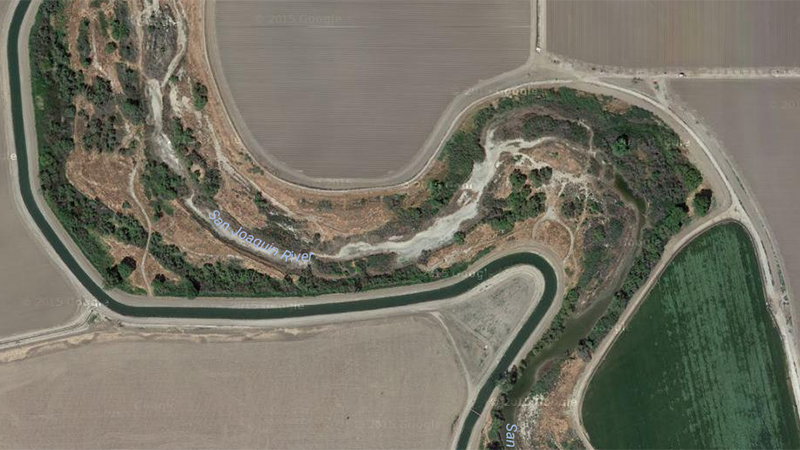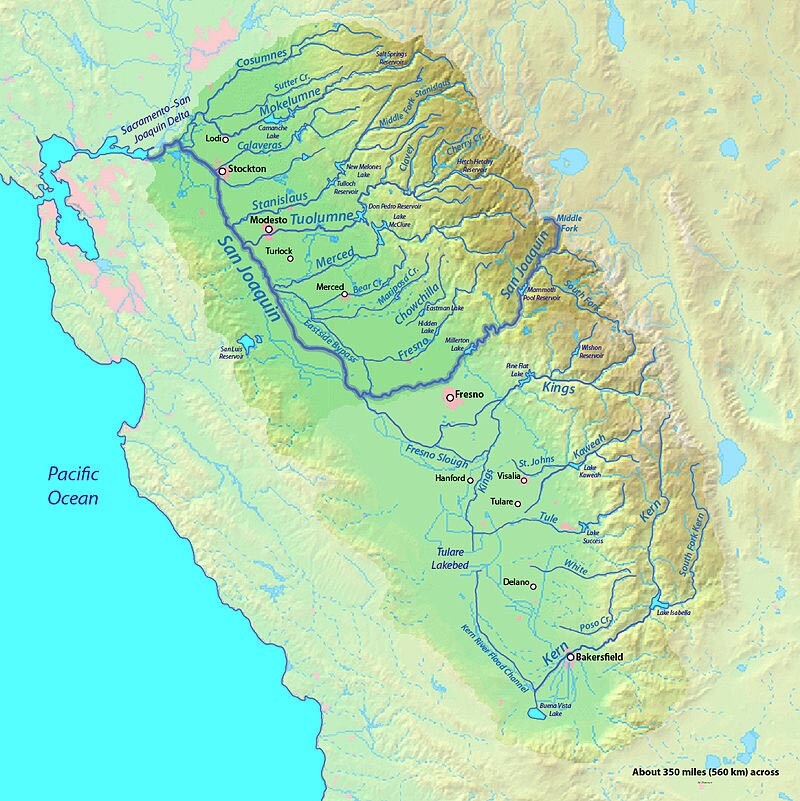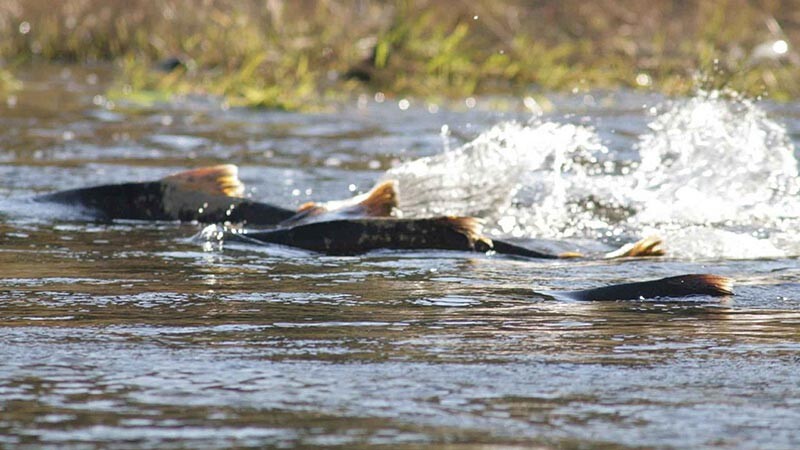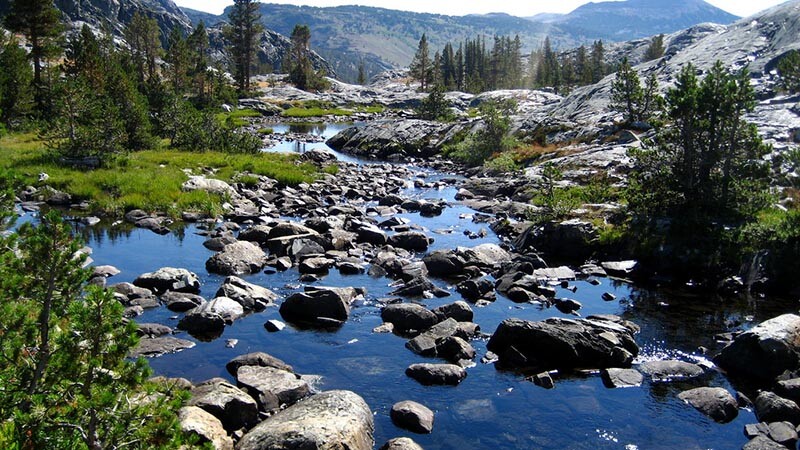Fish Fight! Leaving Water in River For Threatened Salmon Sparks Controversy

A major river in California has so much water taken from it by agribusiness that it runs dry for miles. Now, the state agency responsible for the health of California waterways wants to leave some water in the river and its tributaries for fish and downstream farms. But it’s not going to happen without a fight.
That’s the take-away from the last week of reaction to a proposal by the State Water Resources Control Board to leave more water in three tributaries of the lower San Joaquin River. The proposal comes as part of a draft update to the Board’s decade-old Bay-Delta Water Quality Plan. The Board says the change is needed because people continue to take too much water out of the San Joaquin River system. That threatens both the ecological health of the Delta and the livelihoods of Delta farmers, because with less fresh water flowing in from the south, the Delta’s channels become too saline.
In addition, keeping more water in the Tuolumne, Stanislaus, and Merced rivers between February and June would give a much-needed boost to the San Joaquin’s beleaguered Chinook salmon run.
But the San Joaquin Valley agricultural interests that benefit from water diversions are already gearing up for battle, with local legislators delivering citizen petitions to the Board in an attempt to delay the decision. They’re demanding extended public comment time and additional public hearings, saying that limiting water diversions would harm a farming economy already battered by five years of drought.
American society has changed few river systems as thoroughly as it has the San Joaquin. Rising from a number of tributaries in the highest part of the High Sierra, the San Joaquin system nourished an amazing abundance of both aquatic and terrestrial wildlife, along with the people that depended on that wildlife. Seasonal floods fed a chain of wetlands reaching to the Delta from around the present-day location of Corcoran 200 miles north to the Delta; in exceptionally wet years, those floods likely also fed Tulare Lake to the south, the largest freshwater lake west of the Mississippi.
Almost as soon as white settlers reached California, they set about re-engineering its rivers. First through hydraulic mining, then through aqueduct diversions, and finally through massive dams, the Central Valley’s rivers were altered one by one mainly for the benefit of industry.

The San Joaquin’s current woes really started in 1930, when construction began on the huge Friant Dam northeast of Fresno. By the time the dam was completed in 1942, the river’s fate was sealed. Tulare Lake showed the future of the San Joaquin: due to diversions from the Kings, Kern, and Kaweah, Tulare had been mostly bone-dry for half a century by the time Friant was finished.
Within a short time after the dam was finished, so were the upper San Joaquin’s salmon. Water from the river, impounded in Millerton Lake, was diverted to San Joaquin Valley irrigators. The river often went dry in summer for stretches of 60 miles or more. Chinook once swam into the San Joaquin in spring and fall runs, spawning as far upstream as 16 miles past Friant Dam. After the 1940s, they couldn’t make it much past the river’s confluence with the Merced at Hills Ferry.
Even downstream from the spot where the Merced joined the San Joaquin, conditions have been none too good for salmon. Agricultural drainage canals add dissolved salts to the river, as well as runoff pollution from both agricultural and residential sources.
Since 1978, the State Water Resources Control Board has issued Water Quality Control Plans to set standards for water quality in the Bay and Delta. The most recent update of that plan was published in 2006. Among many other things, it mandated ongoing measurement of both river flows and salinity at a spot on the San Joaquin River near Vernalis, just a few miles from the point where the Delta begins.
The Board now says that one monitoring station isn’t enough, as it doesn’t provide information on the health of each of the major tributaries flowing into the San Joaquin upstream from Vernalis.
The board also says that what information it does have about flows in the Stanislaus, Tuolumne, and Merced rivers indicates that from 1984 through 2009, the average amount of water diverted from each of those rivers during the critical spring salmon migration was 60, 79, and 74 percent, respectively. Those percentages are historical medians, which means that half the time even more water would be taken from each of those rivers.
That’s a problem. Not only do low flows mean the water is likely too warm — or too nonexistent — for salmon spawning, but salmon are thought to home in on their rivers of birth by reading the different smells of each river’s water. Lower flows means less reliable GPS for the Chinook to use in getting to their home streams. And the Spring run of Chinook in these waters, part of the Central Valley Spring Run, is legally considered a Threatened species, so the state is obligated to take steps to preserve them.
That’s why the Board is proposing new water quality standards that would require average flows of between 30 and 50 percent of the three rivers’ total supply be left in the rivers for the salmon.
In a summary of the proposed changes to the Plan for the San Joaquin watershed, the State Water Resources Control Board said that expanding knowledge of the Delta ecosystem is driving the adjustments in water quality standards:
The refined salinity requirements reflect updated scientific information about salt levels that reasonably protect farming in the southern Delta. The new flow requirements for the San Joaquin River’s major tributaries recognize the vital role upstream water flows provide for habitat and migratory signals for threatened and endangered salmon and steelhead. In sum, the draft proposes increasing flows for fish and wildlife and adjusts the salinity requirements to a slightly higher level to reflect updated scientific knowledge.
Some of the details of additional changes to the Bay Delta Water Quality Control Plan, having to do with the Sacramento River’s contribution to the Delta, will be released in a detailed scientific description sometime in the next few weeks.

Reaction to the proposed Plan update is predictably mixed, with wildlife activists, Delta farmers, and salmon fishery advocates expressing cautious optimism.
“After decades of getting it wrong and driving California's salmon and fishing families into the dust by diverting the water needed by salmon, today the state water board staff took a historic step to right a wrong,” said John McManus, executive director of the Golden Gate Salmon Association. “Let's hope the water board approves the staff's recommendations or stronger standards. The Golden Gate Salmon Association sure hopes so.”
“Dam construction drove San Joaquin River spring run salmon into extinction with no thought at all to the thousands of Californians who rely on salmon to survive,” added McManus. “Now it's up to the Board to enforce the will of the majority over the deep pockets of a very few who would dam and divert all of our salmon rivers until salmon are gone forever."
San Joaquin Valley ag supporters, on the other hand, see the move as a way to reduce their supply of taxpayer-subsidized water. A trio of Congressional Representatives from Valley districts — Jim Costa, Tom McClintock, and Jeff Denham, sent a joint letter to State Water Resources Control Board chair Felicia Marcus demanding public hearings on the Plan revision, as well as an extended comment period. They also demanded that the Board prove adding water to the rivers would benefit the fish.
“It is completely unacceptable that the State Water Resources Control Board failed to hold public hearings in the communities most affected by this proposal,” said the three Representatives in a joint statement announcing the release of the letter. “The people, the farmers and communities in the San Joaquin Valley have borne the brunt of the impacts of five years of drought conditions and this proposal, if adopted, would only result in further harm to the economy of the region.”
We can expect much more heat coming from irrigators and their proxies in the months to come as the Board releases more information about the new Plan. But one veteran observer of California water politics thinks the new plan’s mandates of higher spring flows in the Stanislaus, Tuolumne, and Merced will be approved.
“I understand that the local districts have to bluster and fight these instream flow requirements,” writes the pseudonymous blogger “onthepublicrecord,” who runs the highly respected California water site On The Public Record. “I think it is good to have this fight. If the laws protecting fish flows aren’t ever used or don’t hold up, there’s no point in having them. But I predict these recommended instream flows will be upheld.”

Time will tell if onthepublicrecord’s assessment is accurate. In the meantime, there’s an aphorism — usually and inaccurately credited to Mark Twain — that seems ever more appropriate in California, and especially in the Delta: “Whiskey is for drinking. Water is for fighting over.”


